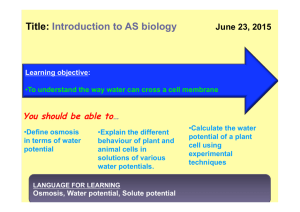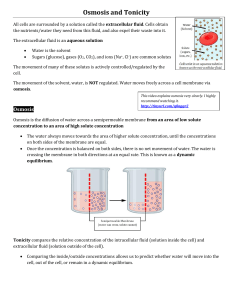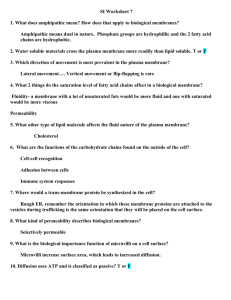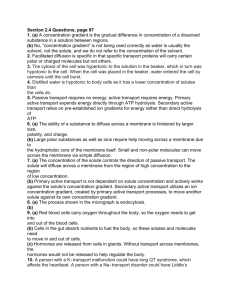Osmosis and Plant Water Relations
advertisement
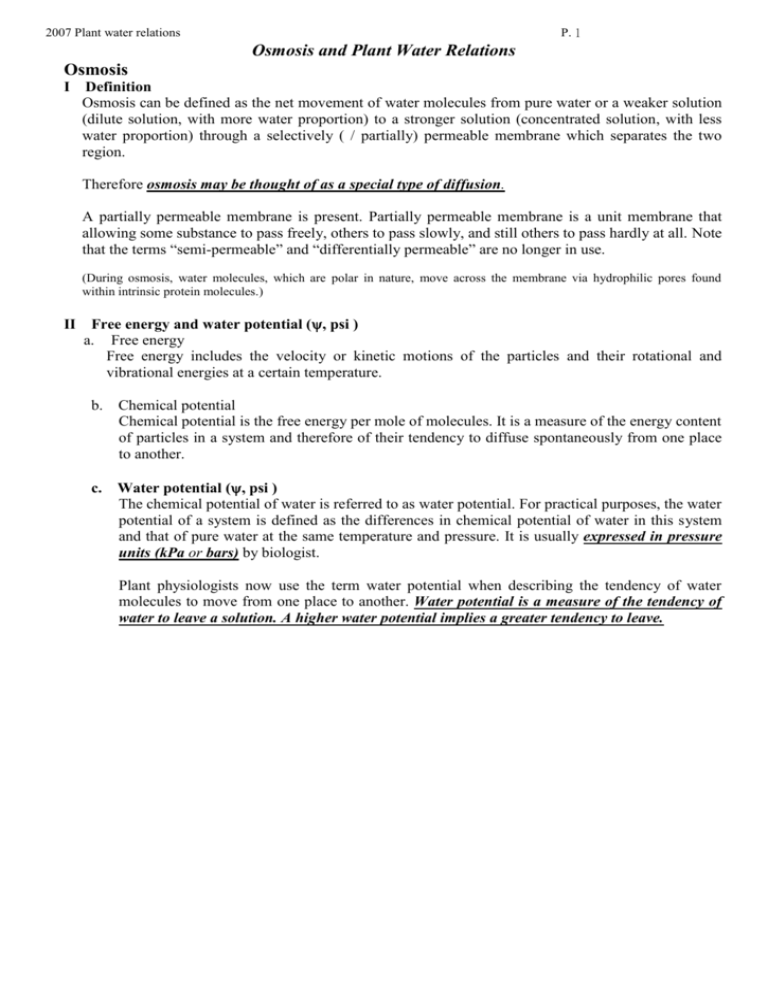
P. 1 2007 Plant water relations Osmosis and Plant Water Relations Osmosis I Definition Osmosis can be defined as the net movement of water molecules from pure water or a weaker solution (dilute solution, with more water proportion) to a stronger solution (concentrated solution, with less water proportion) through a selectively ( / partially) permeable membrane which separates the two region. Therefore osmosis may be thought of as a special type of diffusion. A partially permeable membrane is present. Partially permeable membrane is a unit membrane that allowing some substance to pass freely, others to pass slowly, and still others to pass hardly at all. Note that the terms “semi-permeable” and “differentially permeable” are no longer in use. (During osmosis, water molecules, which are polar in nature, move across the membrane via hydrophilic pores found within intrinsic protein molecules.) II Free energy and water potential (, psi ) a. Free energy Free energy includes the velocity or kinetic motions of the particles and their rotational and vibrational energies at a certain temperature. b. Chemical potential Chemical potential is the free energy per mole of molecules. It is a measure of the energy content of particles in a system and therefore of their tendency to diffuse spontaneously from one place to another. c. Water potential (, psi ) The chemical potential of water is referred to as water potential. For practical purposes, the water potential of a system is defined as the differences in chemical potential of water in this system and that of pure water at the same temperature and pressure. It is usually expressed in pressure units (kPa or bars) by biologist. Plant physiologists now use the term water potential when describing the tendency of water molecules to move from one place to another. Water potential is a measure of the tendency of water to leave a solution. A higher water potential implies a greater tendency to leave. 2007 Plant water relations P. 2 III Components of water potential in a plant cell In plant cells, water potential has two main components: Osmotic potential () / solute potential (s) and Pressure potential (p). a. Osmotic potential ( ) / Solute Potential (s) Osmotic potential is defined as the component of water potential that is due to the presence of solute i.e. sucrose, solute particles decrease the free energy and hence the chemical potential of the solvent molecules. Thus in a cell system an increase in the solute concentration would lower its water potential. It is a measure of the tendency of a solution to pull water into it, it always has a negative value. The term “solute potential” is the new name for “osmotic potential”. Thus solute potential is always negative (-Ve) in sign. The osmotic potential of a plant cell is defined as the component of the cell’s water potential that is due to the presence of solutes. Another term osmotic pressure (OP) which is measured in a non-living system using osmometer, which contains an artificial partially permeable membrane (see figure below). The osmotic pressure referred to the potential (theoretical) pressure is given a positive (+Ve) sign and has a magnitude equal to solute potential. It is the pressure that must be applied to prevent entry of water into the glucose solution. The opposite force, the solute potential, is the tendency of the glucose solution to gain water from pure water across the membrane . The term “osmotic pressure” is no longer used in plant studies. Instead, descriptions of solutions should be given in term of water potential. However, the term is still used in animal studies. The solute potential of a plant cell has following characteristics: ( i ) It is always -Ve . ( ii ) The negative value of solute potential of a solution means if a solution is separated from pure water by a selectively permeable membrane. Water will always enter the solution as the water potential of a pure water is higher (pure water = 0, which is greater than a negative value.) ( iii ) The value of solute potential of a solution is determined by the concentration of the solution. The more concentrated a solution is, the lower is its solute potential (i.e. more negative) and vice versa. P. 3 2007 Plant water relations b. Pressure potential (p) When a plant cell is immersed in pure water or hypotonic solution, there is a net influx of water. As a result, the cell swells. However unlike animal cells, the plant cell does not burst. This is because the cell wall is stretched and develops a tension, resisting further uptake of water into the cell and therefore further expansion of the cell. As water enters the cell the protoplast enlarges and creates a pressure against the cell wall (the turgor pressure, TP). In turn, a hydrostatic pressure (the wall pressure , WP) is act against on the expanding protoplast by the cell wall. This is called the pressure potential. (Turgor pressure is a real pressure rather than a potential one, and can only develop to any extent if a cell wall is present.) This hydrostatic pressure is used to force water out from the expanding cell. And pressure potential is regarded as the capacity of the existing hydrostatic pressure of a cell to drive water out of it. The pressure potential of a plant cell is defined as the component of the cell’s water potential that is due to hydrostatic pressure. In most cases, pressure potential is usually a positive force, then it is positive ( +Ve ) in sign. II. The Vaculated cells cell water potential of the cell = s + solute potential of the cell p pressure potential of the cell P. 4 2007 Plant water relations 1. plasmolysed cell The volume of cell decreases as water flows out of the vacuole by osmosis. When the plasma membrane starts to pull away from the cell wall. The space between the cell wall and plasma membrane will be filled with the outside solution. This withdrawal of the plasma membrane from the cell wall is called plasmolysis. let then p = s = cell = = = zero -X bars s+ p (-X + 0) bars -X bars The point when the plasma membrane starts pulling away from the cell wall (or the plasma membrane just touching the cell wal without acting any force on it) is called incipient plasmolysis. Full plasmolysis is reached when the plasma membrane has completely withdrawn from the cell wall. 2. turgid cell - since a hydrostatic pressure exerted by membrane against cell wall and the plant cell wall is permeable to water, and is rigid and slightly elastic. ---> and equal and opposite pressure exerted by the cell wall on water molecules in vacuole (i.e. p > 0) cell = s (-ve in value) + p (+ve in value) The pressure potential reaches its maximum when the cell wall is stretched as much as it can be and the cell cannot take in any more water. At this point, the cell is described as fully turgid, i.e. full turgor is achieved. 3. in xylem vessels - transpiration is pulling water up the plant ---> p < 0 cell = s (-ve in value) + p (-ve in value) 4. cells in different solutions - since water tends to diffuse from high cell i. to low cell region : in hypotonic solution cell < of bathing solution around cell ---> water rush into cell by osmosis ---> swell of protoplast ---> turgid ii. in hypertontic solution cell > of bathing solution around cell ---> water out the cell by osmosis ---> shrinks of protoplast ---> plasmolysis (flaccid) iii. in isotonic solution cell = of bathing solution around cell ---> no osmosis occurs

